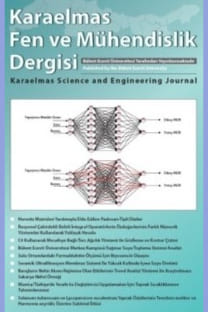NiN (N=6-55) Kümelerinin Geometrik Büyümesi ile Erime Davranışı İlişkisinin İncelenmesi
Kümeler, Nikel, Erime, Moleküler Dinamik, Termodinamik, Sutton-Chen Potansiyeli, Çoklu Histogram Yöntemi.
The Investigation of the Relationship Between Geometrical Growth and Melting Behavior of NiN (N=6-55) Clusters
Clusters, Nickel, Melting, Molecular dynamics, Thermodynamics, Sutton-chen potential, Multiple histogram methods,
___
- Aguado, A.,Jarrold, M.F. 2011. Melting and Freezing of Metal Clusters. Annu. Rev. Phys. Chem., 62: 151-72. https://doi.org/10.1146/annurev-physchem-032210-103454.
- Calvo, F., Labastie, P. 1995. Configurational density of states from molecular dynamics simulations. Chem. Phys. Lett., 247: 395-400. https://doi.org/10.1016/S0009-2614(95)01226-5.
- Cezar, H.M., Rondina, G.G., Silva, J.L.F. 2019. Thermodynamic properties of 55-atom Pt-based nanoalloys: Phase changes and structural effects on the electronic properties J. Chem. Phys., 151: 204301. https://doi.org/10.1063/1.5125689.
- Doye, J.P.K., Meyer, L. 2005. Mapping the magic numbers in binary Lennard-Jones clusters. Phys Rev Lett. 95(6): 063401. https://doi.org/10.1103/physrevlett.95.063401.
- Doye, J.P.K., Wales, D.J., 1998. Global minima for transition metal clusters described by Sutton-Chen potentials. New J. Chem., 22: 733-744. https://doi.org/10.1039/A709249K.
- Eryürek, M. 2005. Simülasyon Yöntemleriyle Kümelerin Termodinamik Niceliklerinin Belirlenmesi. Doktora Tezi, Zonguldak Karaelmas Üniversitesi, 20s. https://tez.yok.gov.tr/UlusalTezMerkezi/tarama.jsp, tez no: 168576.
- Eryürek, M., Güven, MH. 2008. Peculiar thermodynamic properties of LJ N (N = 39-55) clusters. Eur. Phys. J. D, 48 (2): 221-228. https://dx.doi.org/10.1140/epjd/e2008-00094-2.
- Frantz, DD., 2001. Magic number behavior for heat capacities of medium-sized classical Lennard-Jones clusters. J. Chem. Phys., 115: 6136. https://doi.org/10.1063/1.1397329.
- Guvenc, Z.B., Jellinek, J., Voter, A.F. 1991. Phase changes in nickel clusters from an embedded-atom potential. Int. Symp. on the Phys. and Chem. of finite sys.: from clusters to crystals, Richmond, VA (United States). https://doi.org/10.1021/jp962720r.
- Güvenç, Z.B., Güvenç, D., Jellinek, J. 1999. Structural Forms and Energies of NiN, N=12-14, Clusters. Math. Com. App., 4(1): 75-81. https://doi.org/10.3390/mca4010075.
- Haberland, H. 2000. Melting of Clusters. Springer, Les Houches, Session LXXIII pp. 3-26.
- Hamming, R.W. 1959. Predictor-Corrector Methods for Ordinary Differential Equations. J. ACM, 6 (1): 37-47. https://doi.org/10.1145/320954.320958.
- Hewage1, J.W., Rupika, W.L., Amar, F.G. 2012. Structure, dynamic and energetic of mixed transition metal clusters: A computational study of mixed clusters of silver and nickel. Eur. Phys. J. D, 66: 282. https://doi.org/10.1140/epjd/e2012-20691-6.
- Kaatz, F. H., Bultheel, A. 2018. Size, shape, and compositional effects on the order-disorder phase transitions in Au-Cu and Pt-M (M = Fe, Co, and Ni) nanocluster alloys. Nanotechnology 29: 345701. https://doi.org/10.1088/1361-6528/aac6b4.
- Kirkpatrick, S., Gelatt, C. D., Vecchi, Jr., M. P. 1983. Optimization by Simulated Annealing. Science, 220 (4598): 671-680. http://dx.doi.org/10.1126/science.220.4598.671.
- Labastie, P., Whetten, RL. 1990. Statistical Thermodynamics of the Cluster Solid-Liquid Transition. Phys. Rev. Lett. 65: 1567-1570. https://doi.org/10.1103/physrevlett.65.1567.
- Li, T.T., He, C., Zhang, W.X., Cheng, M. 2018. Structural and melting properties of Cu-Ni clusters: A simulation study. J. All. Com. 752:76-84. https://doi.org/10.1016/j.jallcom.2018.04.145.
- Lloyd, L.D., Johnston, R.L. 1998. Modelling aluminium clusters with an empirical many-body potential. Chem. Phys.,15:107-121. https://doi.org/10.1016/S0301-0104(98)00180-3.
- Lu, S., Zhang, J., Duan, H. 2009. Melting behaviors of CoN (N = 13, 14, 38, 55, 56) clusters. Chem. Phys,. 363: 7-12. https://doi.org/10.1016/j.chemphys.2009.06.010.
- Lyalin, A., Hussien, A., Solov'yov, A.V., Greiner, W. 2009. Impurity effect on the melting of nickel clusters as seen via molecular dynamics simulations. Phys. Rev. B, 79: 165403. https://doi.org/10.1103/PhysRevB.79.165403.
- Nayak, Saroj K., Khanna, S. N., Rao, B. K., Jena, P. 1997. Physics of Nickel Clusters:? Energetics and Equilibrium Geometries. Phys. Chem. A, 101 (6): 1072-1080. https://doi.org/10.1021/jp962720r.
- Noya, E.G., Doye, J.P.K., Wales, D.J., Aguado, A. 2007. Geometric magic numbers of sodium clusters: Interpretation of the melting behaviour. Eur. Phys. J. D 43(1):57-60. https://doi.org/10.1140/epjd%2Fe2007-00092-x.
- Oderji, H.Y., Ding, H. 2011. Determination of melting mechanism of Pd24Pt14 nanoalloy by multiple histogram method via molecular dynamics simulations. Chem. Phys., 388: 23-30. https://doi.org/10.1016/j.chemphys.2011.07.011.
- Teng, Y., Zeng, X., Zhang, H., Sun, D. 2007. Melting and Glass Transition for Ni Clusters. J. Phys. Chem. B, 111 (9): 2309-2312. https://doi.org/10.1021/jp070061k.
- Wei, C., Zhao, Z., Fisher, A.,Zhu, J., Cheng, D. 2016. Theoretical Study on the Structures and Thermal Properties of Ag-Pt-Ni Trimetallic Clusters. J. Clust. Sci., 27:1849-1861. https://link.springer.com/article/10.1007/s10876-016-1068-x.
- Wu, X., Chen, S., Sun, S., Chen, Y. 2012. Geometrical structures of gold clusters on Gupta and Sutton-Chen potentials. Com. Theor. Chem., 1002 (15): 43-48 https://doi.org/10.1016/j.comptc.2012.10.001.
- Yıldırım, E.K., Atiş, M., Güvenç, Z.B. 2005. Structure and dynamical properties of AuN, N=12-14 clusters: Molecular dynamics simulation. Int. J. Mod. Phys. C, 16(01): 99-116. https://doi.org/10.1142/S0129183105006966.
- ISSN: 2146-4987
- Yayın Aralığı: Yılda 2 Sayı
- Başlangıç: 2011
- Yayıncı: ZONGULDAK BÜLENT ECEVİT ÜNİVERSİTESİ
Çeşitli Uzunluklardaki PEG’ler Vasıtasıyla PVC’nin “Klik” Kimyası ile Çapraz Bağlanması
Nilgün ASAN, TEMEL ÖZTÜRK, Hasibe KUDU, Ergül MEYVACI, Efkan ÇATIKER
NiN (N=6-55) Kümelerinin Geometrik Büyümesi ile Erime Davranışı İlişkisinin İncelenmesi
Temel VAROL, Serhatcan Berk AKÇAY, Onur GÜLER, Hüseyin Can AKSA, Hamza ÇOLAK
Deneysel Çalışma ile Küf Büyümesi için Yapı Malzemelerinin Kritik Bağıl Neminin Belirlenmesi
Dilek ŞATANA, Bahar TÜRK, Mustafa Erkan KARAGÜLER
Drosophila: Çevresel Kirleticilerin Toksisitesini Değerlendirmek İçin Umut Veren Bir Model
EŞREF DEMİR, Fatma TURNA DEMİR
Yeliz YALÇIN, İshak Özel TEKİN, Rahime Seda TIĞLI AYDIN
Yeni Nesil Yüksek Güçlü IGBT’ler İçin Dinamik Modelleme ve Deneysel Doğrulama
Osman TANRIVERDİ, Deniz YILDIRIM
Levamizolün Model Organizma Galleria mellonella’nın Bazı Biyolojik Özellikleri Üzerine Etkisi
